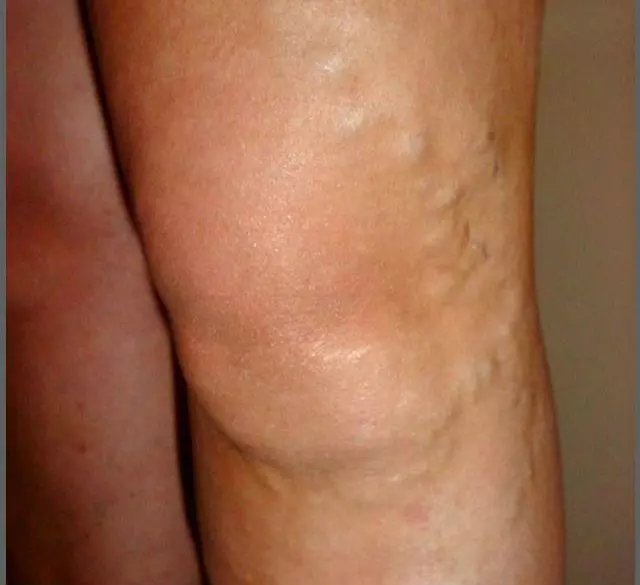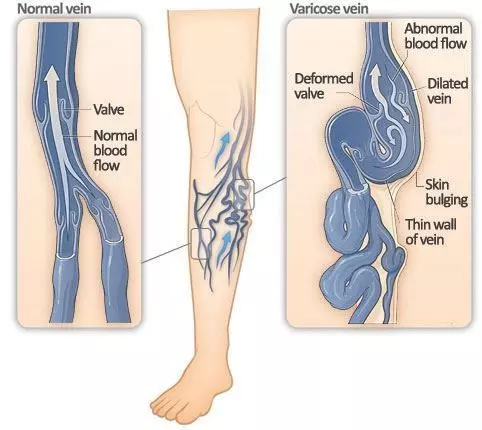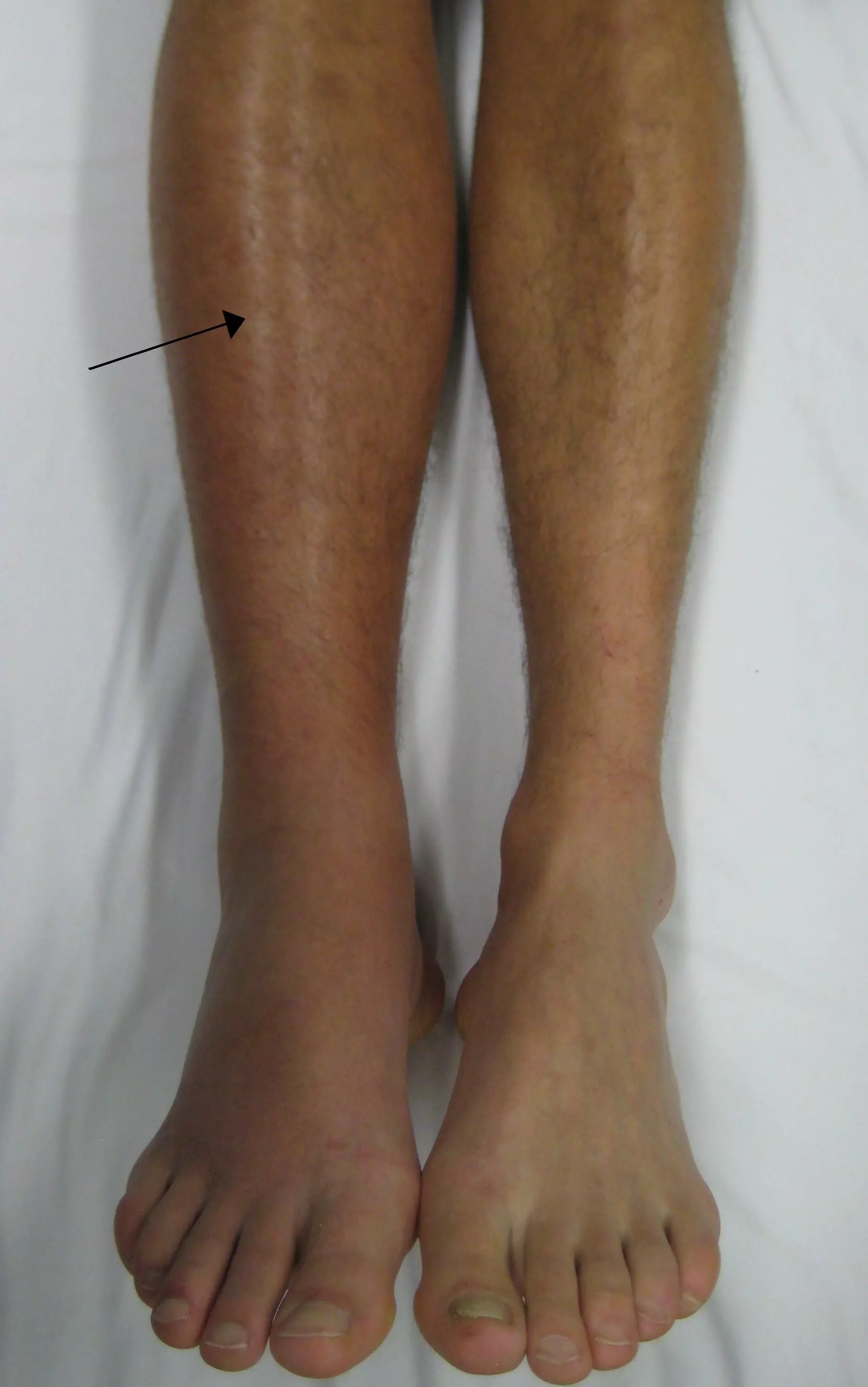By Dr. Thomas Burnell and Bethany Turner
Next Lesson - Acute Coronary Syndromes
Abstract
- Varicose veins are tortuous and dilated veins which are common in the superficial leg veins. Risk factors are older age and pregnancy.
- Complications of varicose veins include haemorrhage, thrombophlebitis and venous hypertension. Venous hypertension can lead to leg ulcers and oedema.
- Arterial stenosis can cause claudication in the associated limb, and absent pulses. Severe stenoses present as rest pain and indicates critical ischaemia.
- Sudden arterial occlusion presents as the six P’s: pain, paralysis, paraesthesia, pallor, perishing cold and pulselessness.
Core
Veinous diseases usually occur as people age, with varicose veins being a common vein pathology.
A varicose vein is a vein that is tortuous, twisted or dilated. The superficial veins of the legs are commonly affected, meaning varicose veins are commonly seen under the skin. This can occur as a result of pregnancy, older age, obesity or having an occupation that involves a lot of standing.

Image - A leg with varicose veins. The veins can be seen bulging from the skin
Creative commons source by Nini00 [CC BY-SA 3.0 (https://creativecommons.org/licenses/by-sa/3.0)]
Normally, venous blood from the legs flows upwards through superficial veins which eventually flow into deeper veins. The flow of blood is assisted by valves in veins which allow blood to move up towards the heart and prevent blood from flowing back down. This ensures that venous blood only flows in one direction.
If the veins become dilated due to the weakening of the wall of the vein, the leaflets of the valves are pulled apart. This lets blood leak back through the valve by the downward pull of gravity (retrograde flow). This causes build-up of blood, increasing the pressure on the valves upstream (in this case valves closer to the feet) of the faulty valve, causing further retrograde flow through these overwhelmed valves. This cycle will continue, and impact further down the superficial venous network, causing blood to pool in the lower legs, forming varicose veins.
Patients often complain of their legs feeling heavy, tense and itchy. As the veins become more damaged, twisted and tortuous, they will push against the skin and cause the skin to appear bumpy.

Diagram - The difference between a normal vein and a varicose vein. In the varicose vein, the veins are contorted, dilated and bulge underneath the skin. Also illustrated is the concept of retrograde flow: venous blood is flowing in both directions through the faulty valve
Creative commons source by Jmarchn, modified from Varicose veins.jpg of National Heart Lung and Blood Institute (NIH) [CC BY-SA 3.0 (https://creativecommons.org/licenses/by-sa/3.0)]
Varicose veins have several associated complications:
- Haemorrhage
- The walls of the varicose veins are thin and bulge from the skin, making them more susceptible to damage through trauma.
- Emergency treatment for this is to simply raise the leg to a level higher than the heart (to help venous blood drain from the leg) and to apply pressure to the bleed.
- Thrombophlebitis
- This is inflammation of a vein caused by the formation of a small clot. The clot forms due to stasis of blood within the varicose vein. The clot is generally of little concern as it is small and unlikely to cause any further complications. However, the inflammation causes symptoms.
- Patients can experience swelling and pain over the affected vein.
- Thrombophlebitis can cause red blood cells to leak from the affected vein into surrounding tissue. Macrophages then break down and oxidise the cells, causing the oxidation of iron in haemoglobin: Fe2+ → Fe3+. The Fe3+ formed stains the skin brown.
- Venous hypertension
The incompetence of the valves in varicose veins means that venous blood struggles to flow. This results in blood pooling at the bottom of the vein, building up the pressure in the vein which causes venous hypertension.
As well as varicose veins, another cause of venous hypertension is calf-muscle-pump failure. The calf muscles play an important part in forcing blood up the deep veins in the calf. Failure of these muscles to contract, for example as a result of immobility or shuffling gait, results in building up of blood in the veins under higher pressure.
Venous hypertension is associated with complications such as:
- Oedema – the blood in the varicose veins is under high pressure and so fluid leaks into the interstitium causing oedema.
- Varicose eczema – fluid leaks from the vein under the high pressure, causing inflammation, which can cause eczema of the overlying skin. These patients are susceptible to developing ulcers.
- Lipodermatosclerosis – inflammation and hardening of the subcutaneous fat due to the inflammation caused by the varicose veins.
- Venous ulceration – fluid leaks from the vein causing swelling and damage to the skin, eventually resulting in an ulcer.
- Deep vein thrombosis (DVT) – the blood flow in varicose veins is stagnant. Due to stasis of blood it can then clot in the deep veins of the leg.
- Symptoms include pain, tenderness and swelling of the leg, distended and warm veins, muscle induration, oedema and pyrexia.
- A DVT can potentially embolise. If part of the thrombus breaks off and travels in the circulation as an embolus, it can travel up to the pulmonary circulation and lodge to cause a pulmonary embolism.

Image - A patient with a deep vein thrombosis in their right leg. The leg is swollen and erythematous compared to the left leg
Creative commons source by James Heilman, MD [CC BY-SA 3.0 (https://creativecommons.org/licenses/by-sa/3.0)]
Arteries can become stenosed (narrowed) as a result of atherosclerosis. Stenosis of arteries can reduce the flow of blood through the artery. This can be observed in some of the vessels of the legs.
Due to the stenosis, patients can experience intermittent claudication. This is pain and cramping in the muscles of the leg when walking or exercising due to the reduced oxygen delivery to the muscles. If the stenosis is more severe, then patients can experience pain in the leg at rest – this rest pain is critical ischaemia. Typically, patients describe this is a heavy and tight pain in the leg. It is only relieved at night if they hang their leg off the bed as this increases blood flow to the calf. If left untreated, arterial stenosis may lead to ulceration and gangrene of the leg.
Locating the stenosis is carried out by checking for pulses in that limb. The main leg pulses from proximal to distal are:
- Femoral – mid inguinal point.
- Popliteal – deep in the popliteal fossa.
- Dorsalis pedis – lateral to the extensor hallucis longus tendon.
- Posterior tibial – behind the medial malleolus.
The patient’s symptoms and pulses will be different depending on where the stenosis is:
- Aortoiliac stenosis:
- Bilateral buttock, thigh and calf claudication
- All lower limb pulses are absent
- Common iliac artery stenosis:
- Unilateral buttock, thigh and calf claudication
- Unilateral absent lower limb pulses
- Common femoral artery stenosis:
- Unilateral thigh and calf claudication
- Unilateral absent lower limb pulses
- Superficial femoral artery stenosis:
- Unilateral calf claudication
- Femoral pulse present, but popliteal and pedal pulses absent
- This is the most common site of artery stenosis
This can occur due to an embolus. Examples of how this can happen include: an abdominal aortic aneurysm (AAA), atherosclerosis, or clot formation in the heart in atrial fibrillation.
Sudden occlusion of an artery is very serious and needs to be treated quickly to avoid damage to the limb.
The signs and symptoms of occlusion of an artery are the six P’s, and result from the lack of blood perfusing the tissues:
- Pain
- Paralysis
- Paraesthesia
- Pallor
- Perishingly cold to touch
- Pulseless
Initially the affected limb will be white as the perfusion to the tissues is severely reduced. After a few hours, the deoxygenated blood in the limb causes it to become cyanotic – there is a blue tinge to the skin which blanches when pressure is applied. As the ischaemia progresses, the skin becomes mottled and no longer blanches. At this stage the limb cannot be saved and must undergo amputation to save the patient.
Edited by: Dr. Ben Appleby
- 11679

